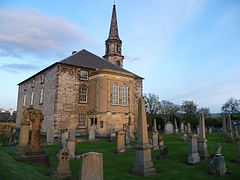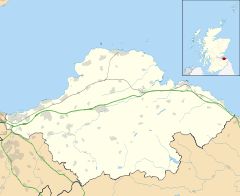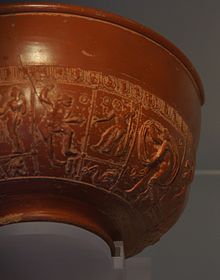- Inveresk Roman Fort
-
Coordinates: 55°56′12″N 3°03′17″W / 55.936541°N 3.054636°W
Inveresk Roman Fort 
Inveresk Parish Kirk, site of the Roman Fort
 Inveresk Roman Fort shown within East Lothian
Inveresk Roman Fort shown within East LothianOS grid reference NT345722 List of places: UK • Scotland • East Lothian Inveresk Roman Fort is an archaeological site within the grounds of St Michael's Church, Inveresk, a village in East Lothian, Scotland. Several seasons of excavation since 1946, both major and minor, have established the outline of the fort and recovered some of the interior detail.[1][2]
The fort covered an area of 6.6 acres (2.7 ha), placing it at the larger end of the spectrum of fort sizes.[3] For this reason, the original excavator, Professor Sir Ian Richmond, believed that a cavalry regiment had been stationed here. Little is known of the interior buildings, so this hypothesis cannot yet be tested. Around 2008 a Roman tombstone was found at Inveresk depicting a Roman Governer's guard cavalry officer called "Crescens" who was stationed and died there.[4]
All of the datable artefacts point to Antonine occupation.[5] Consequently, the fort is thought to have been established in the immediate aftermath of the invasion of Scotland launched by the emperor Antoninus Pius in AD 139/140. Two clear phases of occupation were identified archaeologically, perhaps occasioned by a change of garrison during the Antonine period. The fort will have been abandoned, along with the other Scottish sites, around AD 160, when Hadrian's Wall was recommissioned.
A substantial civil settlement (vicus) lay outside the east rampart of the fort, and included a curving structure thought to be an amphitheatre.[6]
The fort's Roman name remains unknown, although it has been suggested that Ptolemy's Κούρια (Curia or Coria), located in the lands of the Votadini,[7] should be identified with Inveresk, "the name being transferred from a native meeting-place which it controlled (in this case perhaps Arthur's Seat, 4 miles to the west)".[8] It may also have been called "Evidensca" according to the Ravenna Cosmography.[9][10]
Notes
- ^ Richmond, I. A. (1980). "A Roman fort at Inveresk, Midlothian". Proceedings of the Society of Antiquaries of Scotland 110: 286–304. http://ads.ahds.ac.uk/catalogue/adsdata/PSAS_2002/pdf/vol_110/110_286_304.pdf.
- ^ Leslie, A. (2002). "The Roman fort at Inveresk". In Bishop, M. C. (ed.). Roman Inveresk: Past, Present and Future. Duns: The Armatura Press. pp. 17–28.
- ^ Duncan B. Campbell, Roman Auxiliary Forts 27 BC-AD 378 (Oxford: Osprey, 2009), pp. 28-32, on the sizes of auxiliary forts.
- ^ http://news.bbc.co.uk/1/hi/scotland/edinburgh_and_east/7066539.stm
- ^ e.g. J.P. Gillam's report on "The Coarse Pottery", in Richmond, op. cit., pp. 300-302, concluding that "taken as a whole, the group [of pottery] is early Antonine; ... there are no Flavian pieces"; cf. Grace Simpson, "The Decorated Samian Pottery", in Richmond, op. cit., pp. 302-303, dating the three available sherds to "c AD 138-165".
- ^ T. Neighbour, "Excavations on the 'amphitheatre' and other areas east of Inveresk fort", in: M.C. Bishop (ed.), Roman Inveresk: Past, Present and Future (Duns: The Armatura Press, 2002), pp. 41-51.
- ^ Ptol., Geog. II, 3, 7; also found in the Ravenna Cosmography (107.41) as CORITIOTAR, which is thought to be a corruption of Coria Votad(inorum)
- ^ A.L.F. Rivet & Colin Smith, The Place-names of Roman Britain (London: B.T. Batsford Ltd., 1979), p. 320, s.v. CORIA of the Votadini
- ^ http://www.romanmap.com/htm/ravcosm/rc159-189.htm
- ^ http://www.romanmap.com/htm/nomina/Eiudens.htm
References
- M.C. Bishop (ed.), Roman Inveresk: Past, Present and Future (Duns: The Armatura Press, 2002)
Categories:- Roman forts in Scotland
- Archaeological sites in Midlothian
Wikimedia Foundation. 2010.


